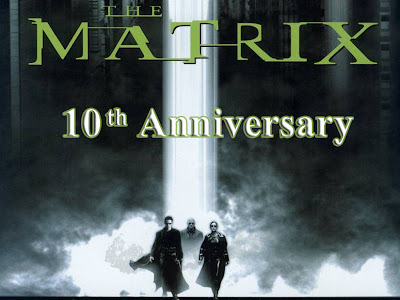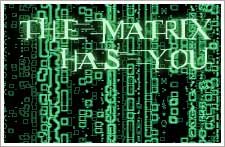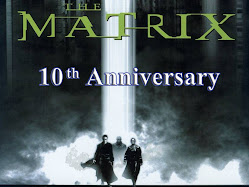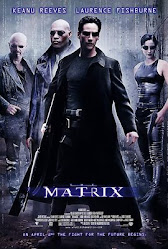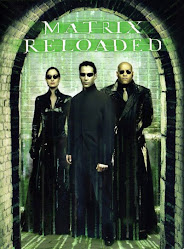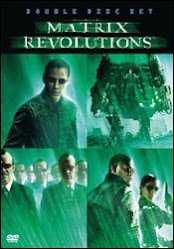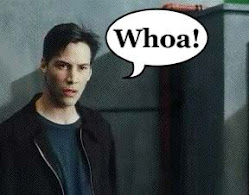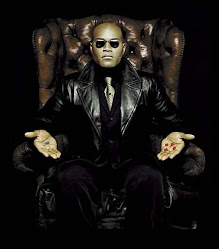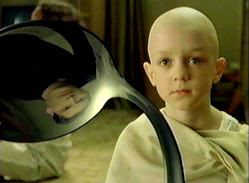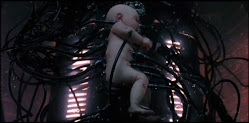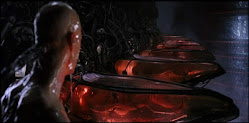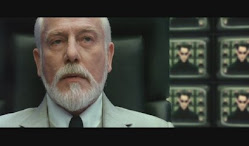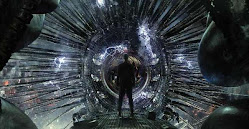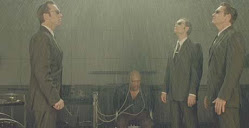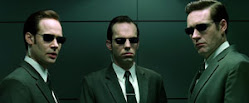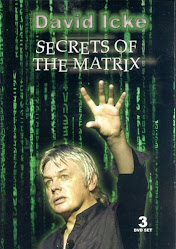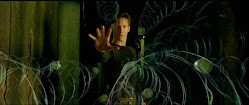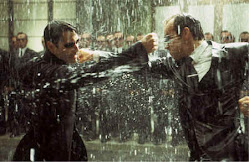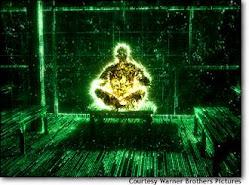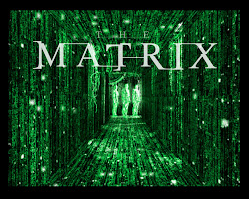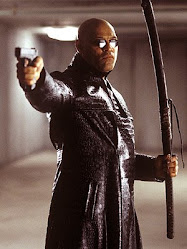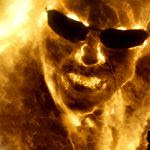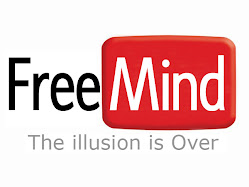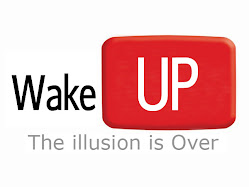“There is no matter as such. All matter originates and exists only by virtue of a force which brings the particle of an atom to vibration and holds this minute solar system of the atom together. We must assume behind this force the existence of a conscious and intelligent mind; this mind is the matrix of all matter” – Max Planck
The ultimate revelation of the first Matrix movie is when the resurrected Neo, no longer sees the world (matrix) as dense, solid matter; instead sees everything around as pure energy at vibrating frequencies (quantum /"codes") . Technically, he unleashed his multidimensional essence, accessing to higher level of consciousness as the evolved human being he wasn’t quite convinced he was, because he was still trapped into the “physical” illusion.
Furthermore, Neo realizes what many seers, mystics, philosophers and scientists have been basically claiming and concluding all along:



“Science cannot solve the ultimate mystery of nature. And that is because, in the last analysis, we ourselves are a part of the mystery that we are trying to solve.” – Max Planck
Max Karl Ernst Ludwig Planck was a German physicist who is widely regarded as one of the most significant scientists in history. He developed a simple but revolutionary concept that was to become the foundation of a new way of looking at the world, called quantum theory.
In 1900, to solve a vexing problem concerning the radiation emitted by a glowing body, he introduced the radical view that energy is transmitted not in the form of an unbroken (infinitely subdivisible) continuum, but in discrete, particle-like units. He called each such unit a quantum (the plural form being quanta). This concept was not immediately accepted by physicists, but it ultimately changed the very foundations of physics.
Planck himself did not quite believe in the reality of this concept—he considered it a mathematical construct. In 1905, Albert Einstein used that concept to explain the photoelectric effect, and in 1913, Niels Bohr used the same idea to explain the structures of atoms. From then on, Planck's idea became central to all of physics.
He received the Nobel Prize in 1918, and both Einstein and Bohr received the prize a few years later. Planck was also a deeply religious man who believed that religion and science were mutually compatible, both leading to a larger, universal truth. By basing his convictions on seeking the higher truth, not on doctrine, he was able to stay open-minded when it came to formulating scientific concepts and being tolerant toward alternative belief.
"It is not the possession of truth, but the success which attends the seeking after it, that enriches the seeker and brings happiness to him.” – Max Planck


"Reality is merely an illusion, albeit a very persistent one."
Einstein's theory of relativity introduced a new way of looking at the physical properties of the universe. The Newtonian constraints of absolute time and space were abandoned. Time and space were unified and made relative, it formed a continuum that curved and enfolded about itself. Gravity was a distortion of this continuum caused by the presence of mass. From this, the famous formula e=mc~ was derived. (e=energy, m=mass, c=the speed of light, the magical constant in the system, the absolute maximum speed that anything can travel.)
Even though Einstein had a deep sense of the mystical or spiritual, he refused to let go of his classical insistence that a rational explanation or theory could be found, i.e., the world was accessible to human reason. This dilemma for Einstein can be seen when he said that he believed in the possibility of expressing everything scientifically, but contradicted himself saying that such an expression would be meaningless when describing a Beethoven symphony as a variation of wave pressure. Of course the meaning and effect of the music would be missing
"When you sit with a nice girl for two hours, it seems like two minutes. When you sit on a hot stove for two minutes, it seems like two hours that's relativity."
- Albert Einstein


“Natural science, does not simply describe and explain nature; it is part of the interplay between nature and ourselves.”
Heisenberg, with mathematical help from Max Born, developed in 1925 the first version of quantum mechanics, a matrix method of calculating the behavior of electrons and other subatomic particles. The method was superseded as a practical tool soon after by the more intuitive wave equation of Erwin Schrödinger, but matrix mechanics remains a great intellectual accomplishment. Heisenberg's most lasting contribution was his discovery in 1927 of the uncertainty principle, a foundation of quantum theory. A few years later he introduced a new quantum number called isotopic spin. Heisenberg continued to contribute to particle physics, introducing useful computational techniques in the 1950s.
Matrix mechanics is a formulation of quantum mechanics created by Werner Heisenberg, Max Born, and Pascual Jordan in 1925.
Matrix mechanics was the first complete and correct definition of quantum mechanics. It extended the Bohr Model by describing how the quantum jumps occur. It did so by interpreting the physical properties of particles as matrices that evolve in time. It is equivalent to the Schrödinger wave formulation of quantum mechanics, and is the basis of Dirac's bra-ket notation for the wave function.
“What we observe is not nature itself, but nature exposed to our method of questioning.” - Werner Heisenberg

So What’s the Point?
Quantum physics tells us that reality is far beyond human perception and intuition. In other words, our rational mind and common sense are just not capable of understanding the true nature of reality.
Sages and seers in ancient times who spoke of the spiritual side of nature, gained their insight by moving beyond the confines of the rational physical world (left brain). In a similar way to the principles of Godel's theorem, the ancient mystics gained access by deep meditation to a perspective beyond the physical, in order to attain a more complete picture of the physical realm.
In other words, when we are within the illusion of physical reality it is not possible using its own internal methods and concepts to fully understand it. By accessing or looking from a higher level of awareness beyond the boundaries of the "physical illusion', we escape the constraints imposed on us by the finite physical world. To a rational scientific person this may all sound like something out of a science fiction novel.
Sages and seers in ancient times who spoke of the spiritual side of nature, gained their insight by moving beyond the confines of the rational physical world (left brain). In a similar way to the principles of Godel's theorem, the ancient mystics gained access by deep meditation to a perspective beyond the physical, in order to attain a more complete picture of the physical realm.
In other words, when we are within the illusion of physical reality it is not possible using its own internal methods and concepts to fully understand it. By accessing or looking from a higher level of awareness beyond the boundaries of the "physical illusion', we escape the constraints imposed on us by the finite physical world. To a rational scientific person this may all sound like something out of a science fiction novel.
More: http://www.sol.com.au/kor/11_01.htm





